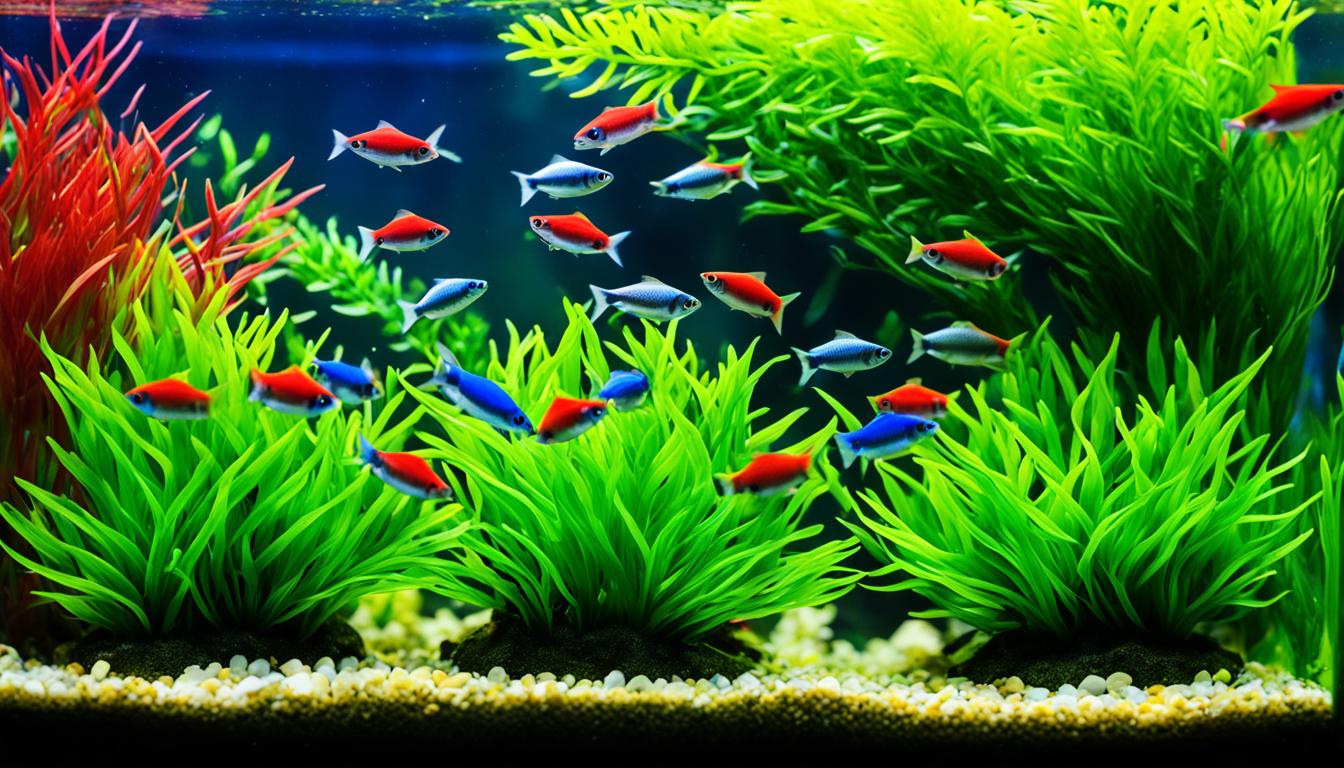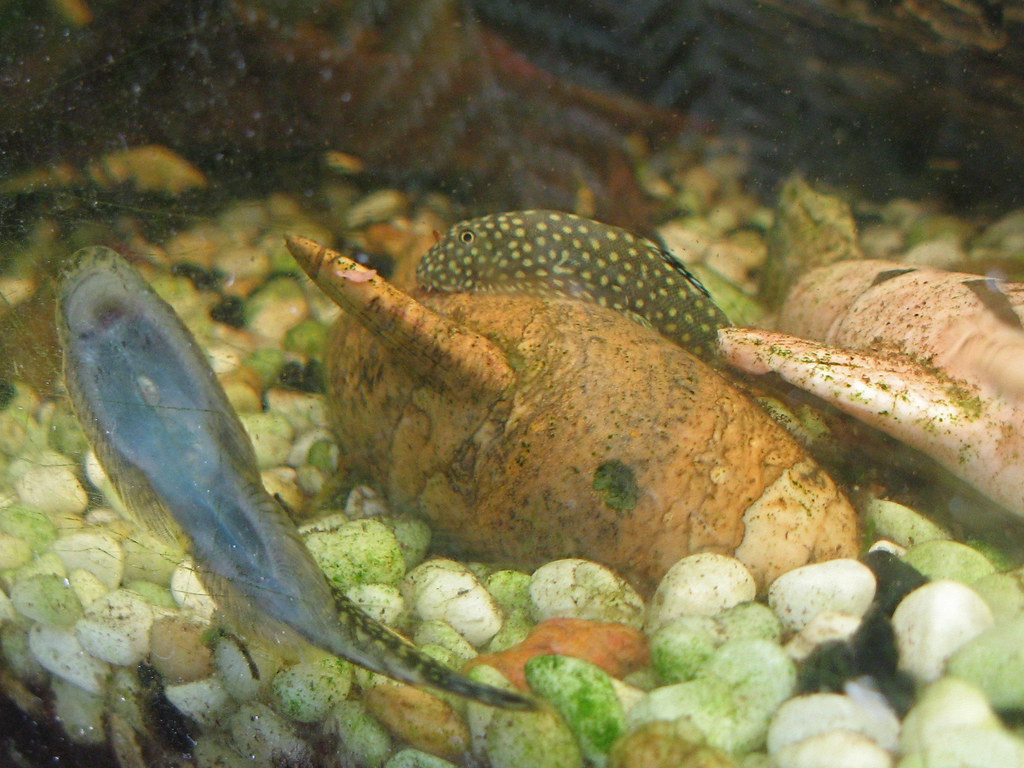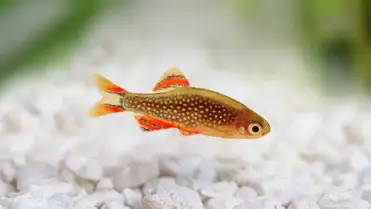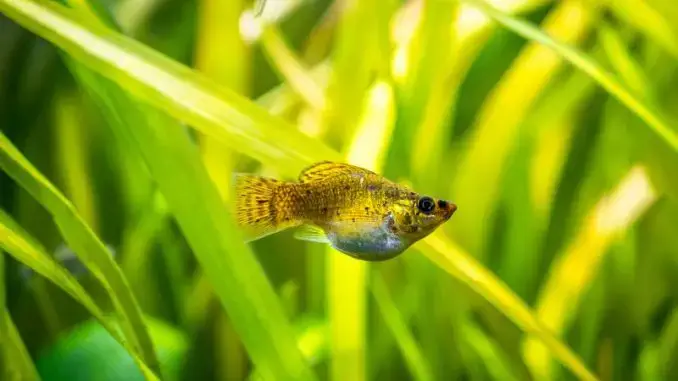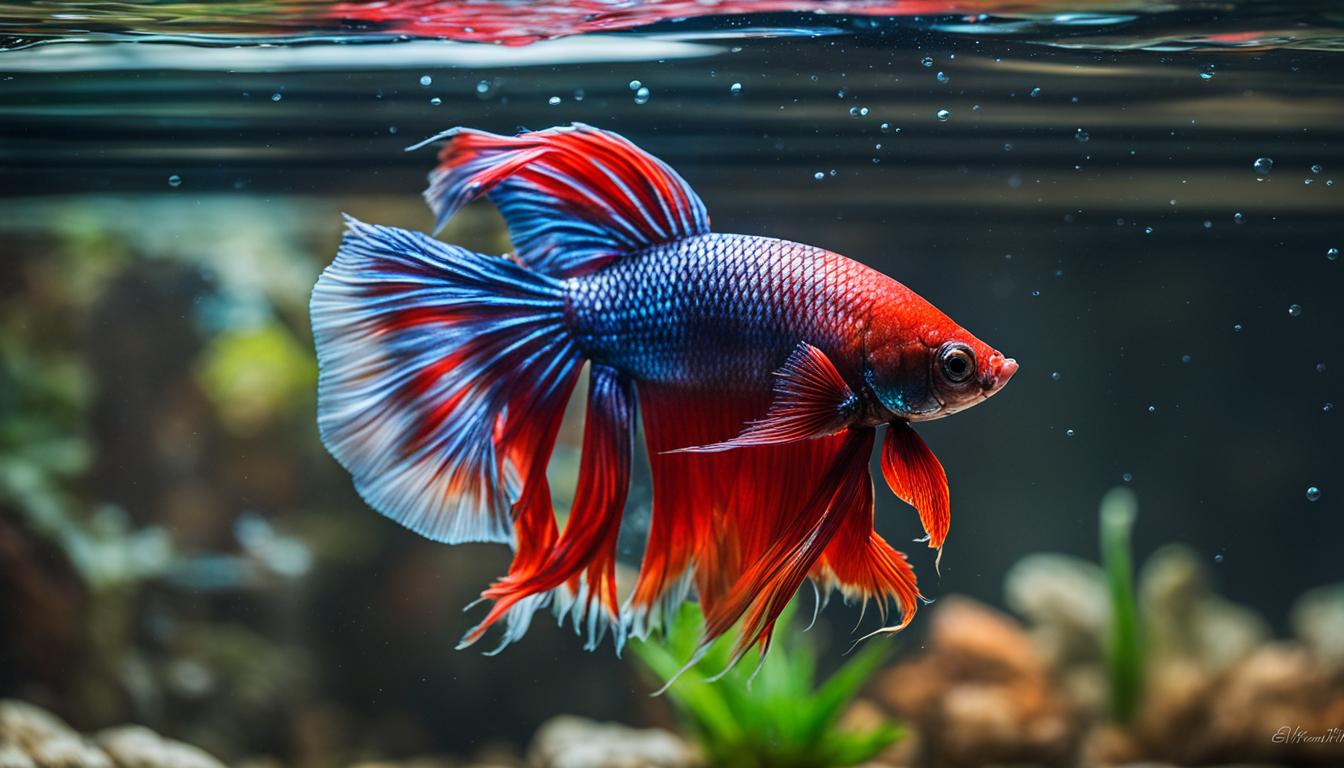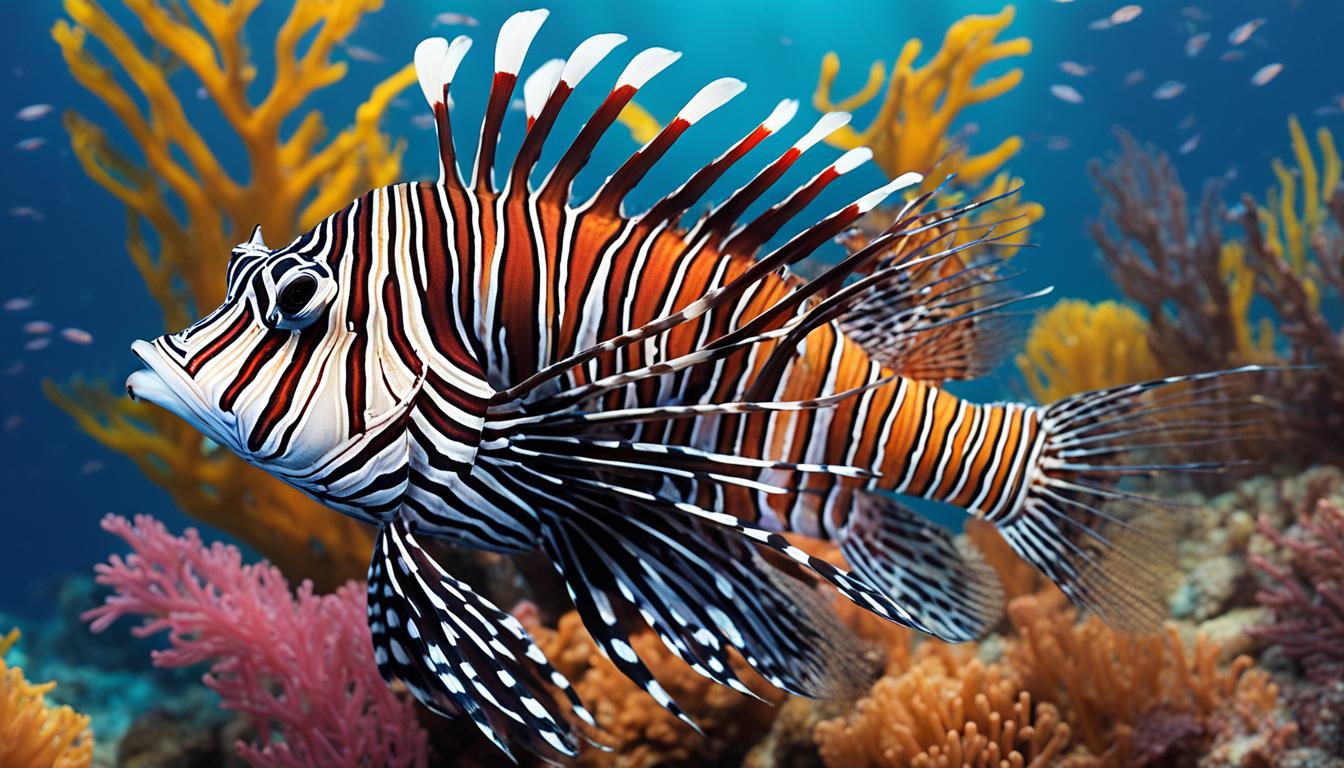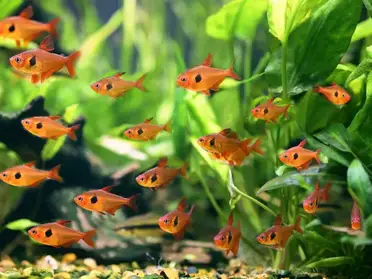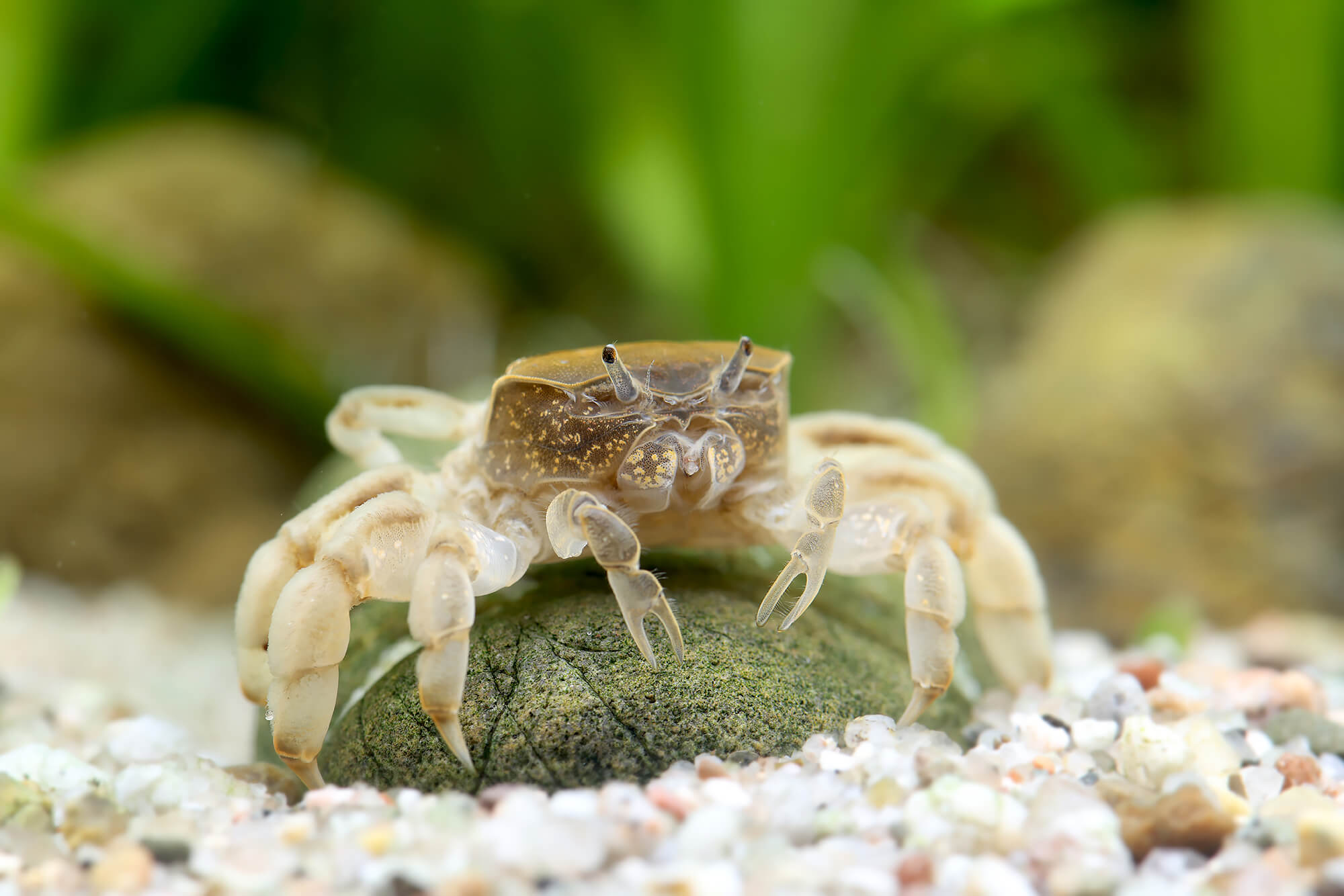Nano aquariums, from 0.5 to 15 gallons, are a hit with aquarium fans. They let you make a beautiful small ecosystem. This is great for anyone who loves fish but has limited space.
Stocking a nano tank means picking small fish that are pretty and fun. Some top choices are celestial pearl danios, which run about $6-10 each. You might also like chili rasboras, which reach 0.8 inches and like to be in groups of 10 or more. Consider pygmy corydoras too. They’re an inch long and need at least 6 friends.
Kuhli loaches, at about 4 inches long, are a great pick. Green neon tetras and ember tetras, about 1 inch, like to be in big groups. Clown killifish, at 1.5 inches, are another good choice. Don’t forget panda guppies. The males are about 1 inch long and the females can grow up to 2 inches.
If you’re just starting, look at the spotted blue eye rainbowfish. They hit about 1.5 inches. The Borneo sucker loach, at 2 inches, is a neat option too. These little guys bring color and fun to small tanks.
Table of Contents
Key Takeaways
- Nano aquariums range from 0.5 to 15 gallons and are gaining popularity among aquarium enthusiasts.
- When stocking a nano tank, choose small, colorful fish with unique personalities.
- Popular nano fish include celestial pearl danios, chili rasboras, pygmy corydoras, kuhli loaches, green neon tetras, clown killifish, ember tetras, panda guppies, spotted blue eye rainbowfish, and Borneo sucker loaches.
- Consider the adult size, schooling requirements, and compatibility of each species when selecting fish for your nano tank.
- Beginner-friendly nano fish options include spotted blue eye rainbowfish and Borneo sucker loaches.
Introduction to Nano Fish Tanks
Nano fish tanks are becoming really popular. They’re loved for their small size and how beautiful they look. These tanks are usually from 0.5 to 15 gallons. They let you make a stunning home for fish in a small space. But, picking the right fish for them is key.
Choosing small, peaceful fish with little waste is important for a nano tank. Most fish are under 2-2.5 cm. This means you can have around 10 in a 30+ liter tank. Harlequin Rasboras, for example, get to 2 inches. They’re perfect for beginners and need at least a 10-gallon tank. These fish like being in groups of at least 6 for their own happiness.
When you’re picking fish, think about how big they get and how hard they are to care for. Scarlet Badis are tiny, just 0.8 inches, and easy for new fish owners. They need a 10-gallon tank. Some other fish might need more care, like Killifish do.
A 30-liter tank is the smallest you should go for fish. Bigger tanks, like 60-55 liters, mean you can have a wider variety of fish. Guppies are great for these. They grow to 4 cm and like community tanks. Fancy Guppies are also good, getting to 2 inches and needing a 5-10 gallon tank.
Tetras are a good option for nano tanks because they’re small and mild. Neon Tetras are 1.5 inches and easy to care for. They need at least a 10-20 gallon tank. Cardinal Tetras are a bit bigger, at 2 inches. They are good for beginners too, needing 15-20 gallons.
It’s best to have only a few types of fish in a nano tank. About 1 cm of fish for every 1 liter of water is the guideline. Only feed the fish as much as they can eat in 2-3 minutes.
Doing small water changes every week is crucial for the fish and the tank’s health. With the right care, a nano tank can be a stunning focal point. Nano tanks let you make beautiful underwater gardens with plants.
Celestial Pearl Danio (Danio margaritatus)
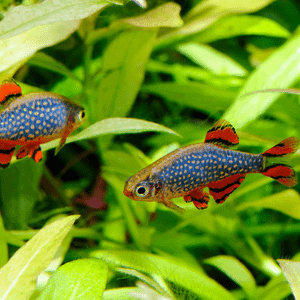
The celestial pearl danio, known as the galaxy rasbora or CPD, charms the aquarium crowd. Its discovery in 2006 was a big deal. It comes from Southeast Asia’s shallow, thickly wooded waters. This small fish, with a 1-inch (2.5 cm) body, shows off golden spots and bright orange fins like a tiny trout.
Origin and Appearance
In 2006, photos of the Danio margaritatus went viral thanks to a Thai fish exporter. Some doubted the images. They thought they might be faked. But, these doubts vanished when the fish went on sale. This species was named Celestichthys margaritatus at first. It was Tyson Roberts who first described it in 2007. Later, in 2008, St. Louis University researchers changed its name to Danio margaritatus. They placed it in the Cyprinidae family and the Actinopterygii class.
Tank Requirements and Care
Celestial pearl danios are best kept in groups of six to fifteen. They like a tank full of plants and hiding places to feel safe. They’re not too picky about water conditions. But they do best in soft to moderate hardness water and a pH of 6.6 to 8.0. Keep the temperature between 72–76°F (22–24°C), with the max at 78°F (26°C).
Pick tank mates that are calm like small tetras, Corydoras catfish, and kuhli loaches for your CPDs. Although peaceful, these tiny fish might chase each other. Avoid keeping them with small shrimp, as they might eat the shrimp babies.
Feed your celestial pearl danios with small slow-sinking food. Frozen cyclops, baby brine shrimp, and daphnia are perfect. They lay eggs in dense plants like java moss. Newborns need food smaller than 50 µm, like infusoria or vinegar eels.
Celestial pearl danios are great for nano tanks, but they can be a bit pricey, going for $6-10 each. With the right care, these galaxy fish will light up your tank like stars.
Chili Rasbora (Boraras brigittae)
Chili rasboras are vibrant, tiny nano fish from Borneo. They are known for their bright red color. These fish live in slow, acidic waters in Southwest Borneo’s peat swamps.
Adult Coloration and Size
Chili rasboras become brighter as they grow. They turn into stunning centerpiece fish for nano tanks. Juveniles from pet stores might look dull at first. But, with good care, they regain their bright colors in about six months.
These fish are very small, only growing to about 0.6 to 0.8 inches. They are slim and can move easily through plants.
Schooling Behavior and Feeding
In the wild, chili rasboras stick together in schools. They do this for safety and show interesting behaviors. To keep them happy in your tank, have at least 8-12 together.
They like to eat from the middle of the tank. They enjoy small, soft food. Feeding them this way helps keep their color bright.
Feed them 2-3 times a day with small amounts they can finish quickly. They like foods like frozen rotifers and baby brine shrimp.
They do well in community tanks with the right water conditions. These include temperatures from 68°F to 82°F, pH levels between 4.0 to 8.0, and water hardness of 3.0 to 12.0 dKH.
Good tank mates are other small, peaceful fish and shrimp. These include species like lambchop rasboras and rosy loaches.
To breed chili rasboras, have at least 6 fish of both sexes. Feed them well. A 1 male to 2 female ratio is best for breeding. Use plastic mesh at the bottom of the tank to keep the eggs safe.
Pygmy Corydoras (Corydoras pygmaeus)
Pygmy corydoras, also known as dwarf corydoras or nano bottom dwellers, are a lovely choice for small tanks. They look like baby cory catfish, even when they’re grown, they are a bit over 1 inch long. You can get these tiny fish for $6.99 each, a great price for fish lovers.
It’s best to keep pygmy corydoras in groups of 5 or more for their happiness. They really enjoy living in groups of 6 or more, just like in the wild. With the right tank mates and a good habitat, they become more lively, making your aquarium more interesting.
For a happy home, pygmy corydoras need at least a 5-gallon tank. The water should be just right, with a pH of 6.0-7.5 and a temperature of 72-78°F. They also need a few more things like a GH of 8 to 16 and KH of 4 to 7. TDS should be 180 to 250.
These fish search the bottom for food, so they’re great for tanks with other small schooling fish. If you can’t find pygmy corydoras, look for other dwarf species. For example, C. habrosus and C. hastatus are good choices.
People really like their pygmy corydoras, saying good things about their health and how lively they are. Although they start off a bit shy, they liven up in the right number and environment.
Expect pygmy corydoras to be about 1/2 inch when you get them, which is small. They will slowly grow to a little over 1 inch, looking just as cute as they did when they were young.
Kuhli Loach (Pangio kuhlii)

Kuhli loaches are also known as coolie loaches. Plus, they get called prickly eyes or slimy loaches. You might even hear them called leopard eels. They’re a special and interesting choice for a nano aquarium. These eel-shaped fish are perfect for beginners wanting something different. They usually don’t get longer than 4.5 inches. So, they’re great for smaller tanks, as they don’t produce much waste, like bigger fish might.
Appearance and Peaceful Demeanor
Kuhli loaches look like little eels, which makes them stand out. They can be the standard color or orange. You might also see black or silver ones, which are very eye-catching in a tank.
Keeping them in groups of five or more is best. Kuhli loaches feel safer this way and will show off their natural behaviors. They often play and eat together.
Care Requirements and Tank Mates
Kuhli loaches do well in a range of water conditions, which is great for beginners. They like their water slightly acidic and fairly warm. A 10-gallon tank is okay for a few loaches. But, if you want to keep more, you’ll need a bigger tank.
These fish eat food that falls to the tank bottom. They love sinking pellets and live food. Nighttime is their favorite time to come out and eat.
When picking friends for your kuhli loaches, choose calm, small fish. Make sure your tank’s filter is safe for them.
With the right care, kuhli loaches can live up to 10 years. Breeding them is hard, but it might happen by accident. These fish add a lot of interest to a community tank. They’re fun to watch and beautiful to look at.
Green Neon Tetra (Paracheirodon simulans)
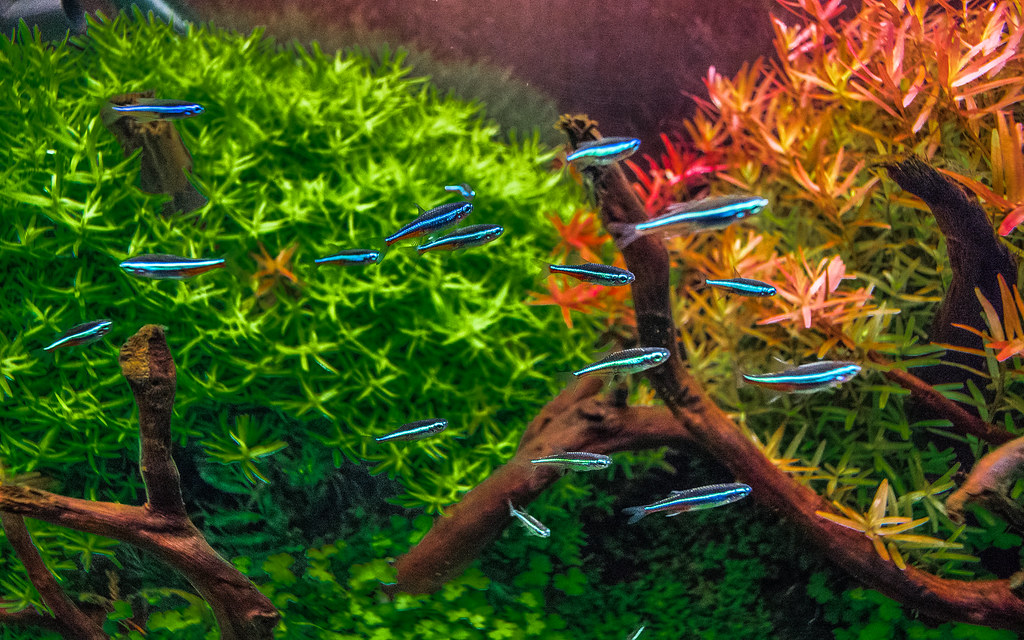
The green neon tetra is a tiny but dazzling fish that lights up small tanks. It’s a smaller cousin to the familiar neon tetra, only reaching about 1 inch in size. Its standout feature is a shiny turquoise line, accented with hints of red.
These fish come from the Rio Negro region in Brazil and the Rio Orinoco area in South America. Because they’re usually caught in the wild, they can be more expensive than other tetras.
To keep green neon tetras happy, mimic their natural homes. They like acidic water but can adapt to pH levels as high as 8. They prefer warm water, between 74–82°F, and need to be with their friends, at least 8 to 10 in a group. For a school to thrive, start with six or more in a 10-gallon tank.
These fish love dark, soft water and a quiet place to swim. Clean water is a must for their wellbeing. Keep nitrates below 15 ppm. They are peaceful and get along well with other calm watermates in the right tank environment.
Breeding green neon tetras takes special conditions. They scatter their eggs and need protection from their parents. A 10-gallon tank with dark, soft water is best. Add a barrier for the eggs, plenty of java moss, and feed the babies often.
When buying these fish, they’re usually between 1/2″ to 3/4″ in size. Since they’re often wild-caught, it’s smart to quarantine them. This step helps prevent introducing disease to your tank.
In conclusion, the green neon tetra is an eye-catching addition to a small tank. Carefully set up their environment, and they’ll delight you with their beauty and charm.
Clown Killifish (Epiplatys annulatus)
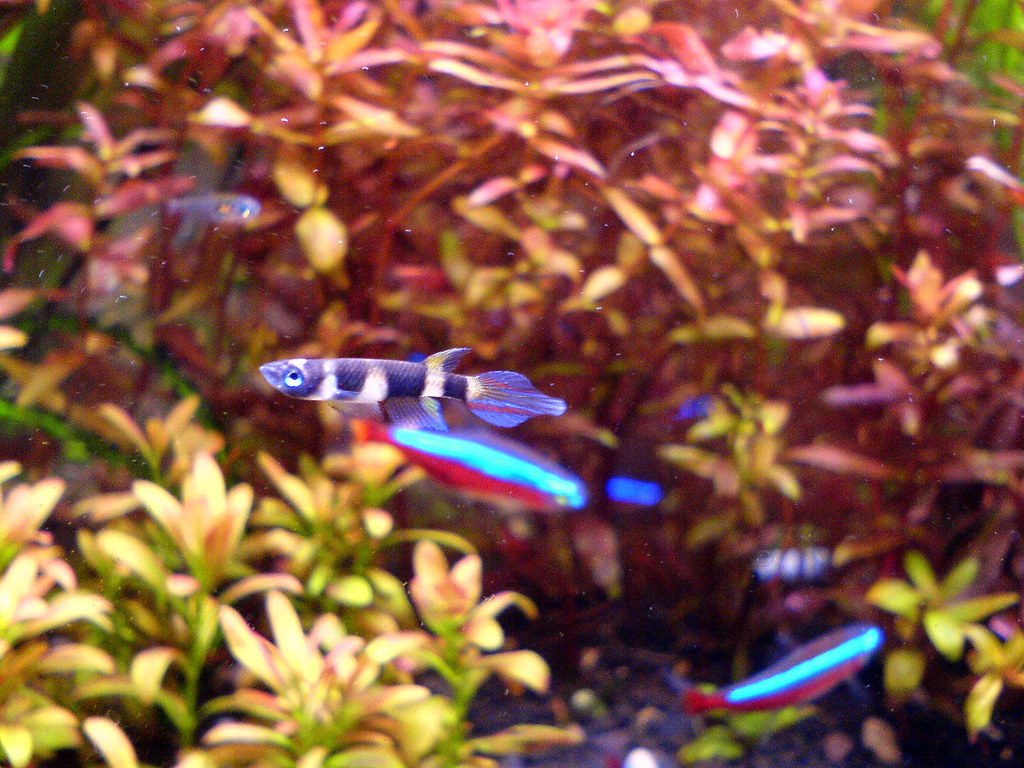
Clown killifish, also known as banded panchax or rocket killifish, light up any nano tank. They stand out with their bright colors. Males have vibrant tones and dark stripes. Females feature a distinctive pattern. They have a banded body but a clear tail. These fish are small, growing up to about 1.4 inches. Usually, you’ll find younger fish in stores, measuring about 0.5 inches. Even though they’re tiny, they can live for 2 to 3 years with good care.
Sexual Dimorphism and Group Ratios
To prevent fights, you need the right mix of clown killifish in your tank. It’s best to have more females than males. Aim for one male with 2 to 3 females. This balance keeps your tank a peaceful place. It also lets the males show off their unique colors. The tails look like flames trailing a rocket.
Jumping Behavior and Feeding Preferences
Clown killifish love staying at the top of the tank. But, this means they might jump out. Make sure your tank has a secure, tight lid. They enjoy eating floating food like tubifex worms and flakes.
Clown killifish blend well in a community tank. They make good friends with other small fish and snails. These fish like their water between 67 and 80 degrees Fahrenheit. The water should be slightly acidic to almost neutral. Make sure it has the right minerals and salts for their health.
| Characteristic | Details |
|---|---|
| Maximum Size | 1.4 – 1.5 inches (3.5 – 3.8 cm) |
| Lifespan | 2-3 years |
| Temperature Range | 67-80°F (19-26°C) |
| pH Range | 5.0 – 7.5 |
| Price Range | $7.99 – $32.99 |
Under the right care, clown killifish will breed. They scatter their eggs on floating plants. About a week and a half later, the eggs hatch. The newborns start to show vibrant colors like red and yellow as they grow.
Ember Tetra (Hyphessobrycon amandae)
The ember tetra, from Brazil, is a small and beautiful fish perfect for small tanks. They are orange-red and very lively, which people love. These fish can live in many different water conditions and reach up to 0.8 inch (2 cm) in length.

Coloration and Hardiness
These tetras stand out with their bright orange-red color. They come from Brazil’s Araguaia River Basin and were discovered in 1987. Ember tetras are tough and can handle changes in water quality. They like a pH of 5.0 to 7.5, temperatures from 72 to 84°F (22 to 28°C), and soft to somewhat hard water.
Schooling Size and Feeding
Ember tetras are more active than some other small fish. They need to be in a group of at least 6-10 to show their best colors and behaviors. A school of these colorful fish is perfect for tanks as small as 5 gallons.
They eat all kinds of food, like small pellets, flakes, and live or frozen tiny creatures. Food options for them include Xtreme Nano pellets, Hikari Micro Pellets, and frozen daphnia. They love to eat together.
| Characteristic | Value |
|---|---|
| Maximum Size | 0.8 inch (2 cm) |
| pH Range | 5.0 – 7.5 |
| Temperature Range | 72 – 84°F (22 – 28°C) |
| Recommended School Size | 6 – 10 individuals |
| Minimum Tank Size | 5 gallons |
| Lifespan | Up to 3 years |
In short, ember tetras are ideal for small community tanks because of their color, activity, and the way they fit into many settings. For those who enjoy nano fish, these Brazilian beauties are a top choice.
Panda Guppy (Poecilia reticulata)
Panda Guppies are a charming type of fancy guppy. They are known for their small size and vibrant look. Many fish lovers pick these nano fish due to their beauty and easy care. Male Panda Guppies are about 1 inch long, and females are a bit bigger. They can grow to 1.75-2 inches in length.
Panda Guppies have a special color scheme that includes blue, silver, and black. These pretty guppies are also tough and can live in small tanks or even outside in warm weather. They are quick to reproduce and don’t need a lot of fussing over their home.
It’s vital to keep Panda Guppies in water they like. They do best in water that is a bit hard and mineral-rich, with a pH over 7.0. If your water is soft, you can add certain products to make it better for them. They prefer water with more minerals and a higher pH, which is typical for smaller tanks.
Feeding Panda Guppies is simple because they eat anywhere in the tank. You won’t need extra fish to clean up after them. But remember not to feed them too much. Give them food once or twice daily, but only what they can eat in a minute.
| Characteristic | Male Panda Guppy | Female Panda Guppy |
|---|---|---|
| Size | 1 inch (2.5 cm) | 1.75-2 inches (4-5 cm) |
| Colors | Blue, silver, and black | |
| Breeding | Livebearers, breed readily | |
| Preferred Water Parameters | pH 7.0+, hard water with minerals | |
| Feeding | Eat at all levels of the aquarium | |
For breeding Panda Guppies, keep one male with two to three females. Ensure there are plenty of hiding spots for the babies. That’s because the mother may eat her young if they can’t hide.
Panda Guppies from stores might need a bit more care due to their breeding. But, they’re great for new and experienced fish keepers. Their stunning looks, small size, and easy breeding can make any small tank more enjoyable.
Spotted Blue Eye Rainbowfish (Pseudomugil gertrudae)
The spotted blue eye rainbowfish, or Gertrude’s rainbowfish, brings vibrant colors to tiny tanks. It reaches just 1.5 inches (3.5 cm) to a max of 2.5 cm. You’ll see a light blue or yellow body with black spots and bright blue eyes.
Appearance and Sexual Dimorphism
Male rainbowfish are brighter than females. To see their best colors and unique dance, try having one male with two females. They’re quite the deal at $7.99 each, perfect for those who love nano tanks.
Water Parameters and Lifespan
These rainbowfish like water with a bit more pH and minerals, like guppies do. Aim for pH 6.5 to 7.5, GH 6 to 15, KH 2 to 5, and TDS 100 to 200. Yet, they can manage in wider conditions too, perfect for tanks without heaters.
They’re known for swimming a lot in the middle area of the tank. A tight lid is a must to keep them from jumping out. They eat floating foods such as high-quality flakes, plus treats like brine shrimp and bloodworms. People love how healthy the fish are when they arrive.
These rainbowfish are not only pretty but also lively. They usually live up to 5 years, which is short for their size. To keep their numbers up, you can try breeding them. Use dense plants or yarn for their eggs, which hatch in about 10 days.
For their best care, have at least 5 or more of these rainbowfish. Set up their tank with special leaves, wood, and more. Remember, a guarantee for live delivery only works with overnight shipping.
Borneo Sucker Loach (Gastromyzon sp.)
The Borneo sucker loach is a small, unique fish from Borneo. It’s part of the Gastromyzon genus. This fish is a great cleaner for small tanks.
They don’t get very big. They fit well in tanks as small as 60 ∗ 30 cm. They look a bit like tiny stingrays. Their bodies are flat, and they have paired fins perfect for fast water.
These fish come from mountain rivers in Borneo. They like cool, clean water with a good flow. Mimicking their natural habitat in a tank is key to their health.
They do well with others of their kind. They like to eat algae and sometimes meaty foods. They should live with peaceful fish that also eat algae.
It’s tricky to breed these fish. People have had some success by copying their wild homes. Some young fish show interesting colors and patterns when they grow up.
| Species Group | Notable Species |
|---|---|
| G. borneensis group | G. borneensis, G. monticola, G. ornaticauda |
| G. punctulatus group | G. punctulatus |
| G. fasciatus group | G. fasciatus |
| G. contractus group | G. contractus |
| G. ctenocephalus group | G. ctenocephalus |
| G. lepidogaster group | G. lepidogaster |
| G. ridens group | G. ridens |
| G. danumensis group | G. danumensis |
| G. pariclavis group | G. pariclavis |
| G. ocellatus group | G. ocellatus |
| G. auronigrus group | G. auronigrus |
The Borneo sucker loach is an amazing fish for small tanks. But, we must protect them and their homes. This way, they can keep adding beauty to our tanks.
Factors to Consider When Choosing Freshwater Fish for Nano Tanks
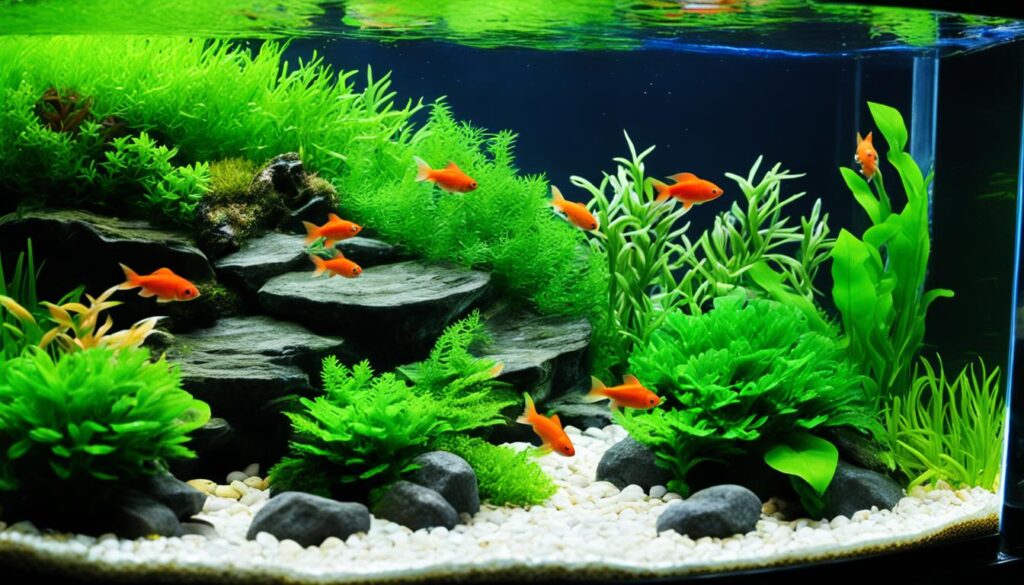
Choosing the right fish for a nano tank is a big decision. You must think about the tank size, how many fish can live there, and their personalities. All these elements are key to making your nano tank a success.
Tank Size and Stocking Levels
Nano tanks come in two sizes: under five gallons and five to fifteen gallons. Fish like bettas or scarlet badis are best for the smallest tanks. They need little space and make just a small amount of waste, but remember, they only grow to 0.8 inches.
For larger nano tanks, from five to fifteen gallons, think about adding small schools of fish. Ember tetras and chili rasboras are great choices. You could also include bottom-dwellers like pygmy corydoras. Always check how big each fish will get and how much waste they produce to avoid overcrowding your tank.
Compatibility and Behavior
Picking fish that get along is crucial for your nano tank’s peace. Look for peaceful fish that like being with others of their kind. Shoaling or schooling fish do well in nano tanks, for example, celestial pearl danios. Make sure the fish you pick have similar water needs and won’t bully or eat each other.
Stay away from big, mean, or hunting fish for your nano tank. They could scare or harm your smaller, more peaceful fish.
Feeding and Care Requirements
Knowing what your fish need to eat and how to care for them is fundamental for a healthy tank. Most nano fish eat both plants and meat. They like tiny, high-quality meals, such as micro pellets or frozen daphnia. Bottom-feeder fish clean up scraps from the tank floor, helping keep things tidy. Others, like Borneo sucker loaches, eat algae off the glass or plants.
Feed your fish a little bit 2-3 times a day. Take out what they don’t eat to keep the water clean. Change some of the water every week and check its quality often to keep your fish happy and healthy.
| Fish Species | Adult Size | Difficulty Level | Minimum Tank Size |
|---|---|---|---|
| Harlequin Rasbora | 2 inches | Beginner | 10 gallons |
| Otocinclus | 2 inches | Beginner | 10 gallons |
| Least Killifish | 1.5 inches | Beginner | 5 gallons |
| Bumblebee Goby | 1.5 inches | Intermediate-Expert | 10 gallons |
| Scarlet Badis | 0.8 inches | Beginner | 10 gallons |
| Neon Tetra | 1.5 inches | Beginner | 10-20 gallons |
| Betta Fish | 3 inches | Intermediate | 5-10 gallons |
| Cardinal Tetra | 2 inches | Beginner | 15-20 gallons |
| Fancy Guppies | 2 inches | Beginner | 5-10 gallons |
Choosing the best fish involves thinking about tank size, how many to add, and their needs. By focusing on these factors, you can make a beautiful home for your fish that also brings you joy.
Creating the Ideal Nano Tank Environment
Setting up the right environment is key for your nano fish tank to thrive. Nano tanks are a great option for those with limited space. However, they can be tough due to quick changes in water quality. For your fish to do well, make sure the filter is good, the water stays stable, and the tank’s design includes hiding places and boundaries for your fish.
Filtration and Water Parameters
Good filtration is critical. It keeps the water clean and your fish healthy. Pick a filter made for small tanks, like a tiny hang-on-back, a sponge filter, or a small canister filter. Avoid those that make strong currents, which can bother your fish. For tanks under 10 gallons, you might not even need a separate heater.
Test the water often for ammonia, nitrite, nitrate, pH, and temperature to keep it steady. Most nano fish do best in slightly acidic to neutral water and temperatures of 72-78°F. Now and then, you might find fish that like harder, more alkaline water. It’s a good idea to change some of the water each week to keep the tank fresh.
Aquascaping and Hiding Spots
Creating the right look for your tank not only makes it nice to look at but also gives your fish important spaces to hide and explore. Use a mix of real and fake plants, driftwood, rocks, and other decorations to build a natural scene. Many nano fish feel best in areas that are full of plants, where they can hide and be safe.
Plants like Java moss, anubias, and small cryptocoryne species work well in small tanks. For fish, consider tiny schooling types like tetras and rasboras. The Boraras species, also called Rasbora, are cool for little tanks. And you can’t go wrong with various Corydoras catfish types for the bottom of the tank.
| Nano Tank Inhabitants | Characteristics |
|---|---|
| Cherry Shrimp (Neocaridina davidi) | Popular choice for freshwater nano tank setups |
| Crystal Shrimp (Caridina cantonensis) | Favored option for nano tanks |
| Mexican Dwarf Crayfish (Cambarellus patzcuarensis) | Small invertebrate suitable for nano tanks |
| Zebra Nerite Snail (Neritina natalensis) | Recommended for snail keeping in nano tanks |
Give your active fish enough space to swim around, like ember tetras and spotted blue eye rainbowfish. A well-planned habitat makes your fish less stressed and encourages natural behavior. Start with good care habits from the beginning to prevent problems. Overfeeding can spoil the water, so be careful with the amount of food. Keeping track of your water and care actions can help you keep everything in check.
Focus on filtration, keep the water’s condition steady, and create a setting that fits your fish. With the right attention, your nano tank will be a great home for your fish.
Maintaining a Thriving Nano Fish Community
Keeping your nano tank thriving means sticking to a regular care schedule. This includes doing weekly water changes of 10-20%. Your tank’s size and how many fish you have will guide choosing the right amount to change. Make sure to clean the tank’s bottom with a gravel vacuum to get rid of waste.
It’s also vital to clean your filter monthly. Wash it in water that’s free from chemicals to protect the helpful bacteria inside. Your aquarium should have a filter that can turn over its entire volume three to five times every hour. For a 20-gallon tank, a filter with a flow rate of 60-100 gallons per hour is perfect.
Scissoring your water plants and picking out any bad ones keeps water moving freely and clean. For tanks with only fish, a good rule is 1 to 2 watts of light for each gallon. So, a 30-watt light that’s 36″ long works well for tanks from 15 to 30 gallons. Watch your fish every day to spot any troubles early. Address any problems fast to maintain the health of your nano fish. Even though some fish, like platies and mollies, are small, they enjoy living in tiny tanks if there are no much larger fish around.
Keeping the water just right and making sure your fish have a balanced place to live are the secrets to nano tank success. Aim to use heaters that provide 3 to 5 watts for each gallon of water, and you’re on the right track. For the bottom of the tank, 1 pound of substrate is good for each gallon of water if it’s an inch deep. Double that if you want a 2-inch layer. Care and effort pay off big time. Your nano fish world will thrive, giving you happiness for many years.
FAQ
What are the best freshwater fish for nano tanks?
What factors should I consider when choosing fish for my nano tank?
How do I create the ideal environment for my nano fish?
Can I keep schooling fish in my nano tank?
What should I feed my nano fish?
How often should I perform water changes in my nano tank?
Can I keep shrimp or snails with my nano fish?
How can I prevent my nano fish from jumping out of the tank?
What signs should I look for to ensure my nano fish are healthy?
References
- The American Cichlid Association: https://www.cichlid.org/
- The North American Native Fishes Association: https://www.nanfa.org/
- The American Killifish Association: https://www.aka.org/
- The Livebearer Association: http://www.livebearers.org/
- The Catfish Study Group: http://www.catfishstudygroup.org/
- The British Killifish Association: https://www.bka.org.uk/
- The International Betta Congress: https://www.ibcbettas.org/
- The International Fancy Guppy Association: http://www.ifga.org/
- The International Livebearer Society: https://www.ils-livebearers.org/
I am a passionate aquarist with over 30 years of hands-on experience in fishkeeping. My journey began at a young age, collecting fish from the wild and learning through experimentation. Specializing in tropical fish, I bring a deep understanding of the hobby to FishKeepingMadeSimple. The site provides honest, detailed reviews of essential products and accessories to help fellow enthusiasts create the best environments for their fish.

